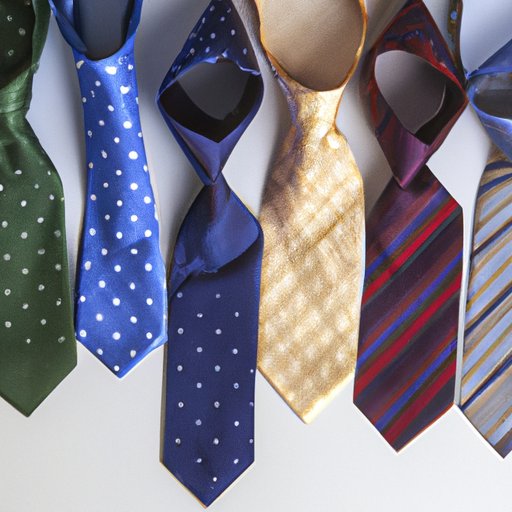Introduction: Why Were Ties Invented?
The necktie has become an iconic piece of clothing, but what is its purpose? What inspired its invention and how has it evolved over time? This article will explore these questions by looking at the historical context, styles, and significance of ties. We’ll also investigate the psychology behind wearing a tie and discuss its functionality in society today.
Historical Context: Exploring the Origins of Ties
The modern necktie has its roots in ancient Rome, where it was worn as a type of scarf or cravat. This early version of the necktie was used to mop up sweat during physical activities and provide warmth in cold climates. Over time, the necktie evolved into a more decorative accessory and began to be used as a symbol of power and status.
The modern necktie first appeared in the 1600s in Croatia, where it was known as the cravat. These early ties were made of linen and featured intricate knots that set them apart from the plain cloth scarves that had preceded them. By the 1700s, neckties had become popular among French aristocracy and were used to distinguish social classes. The modern necktie as we know it today emerged in the late 1800s, when it became a staple of business attire.

The Art of Wearing a Tie: A Comprehensive Guide
Wearing a tie is an art form in itself. It’s important to understand how to tie a tie properly, which colors and patterns work best, and what level of formality is appropriate for different occasions. Here are some tips for mastering the art of wearing a tie.
Different styles of tying a tie. There are many different ways to tie a tie, from the classic four-in-hand knot to the more complicated Eldredge knot. It’s important to practice different knots until you find one that works for you.
Choosing the right color and pattern. The color and pattern of your tie should complement the rest of your outfit. Stick to classic colors like navy, gray, and black for formal occasions, and experiment with brighter colors and bolder patterns for more casual events.
Proper etiquette for wearing a tie. When wearing a tie, make sure the length is appropriate (it should reach just below your belt buckle) and the knot is centered and symmetrical. Avoid wearing a tie with shorts or flip-flops, as this can look sloppy.
Investigating the Role of Ties in Fashion and Culture
Ties have long been used as a symbol of status and power. In the past, they were worn by wealthy aristocrats and members of the clergy. Today, they are seen as a mark of respect and professionalism, signaling that the wearer takes their job seriously. Ties are also a reflection of changing trends in fashion, from wide, colorful ties in the 1970s to skinny ties in the 1980s.
In many cultures, wearing a tie is seen as a sign of respect. For example, in Japan, it is customary to wear a tie when attending a funeral. In the United States, wearing a tie to a job interview is seen as a sign of respect for the interviewer. Even in informal settings, such as a dinner party, wearing a tie can signal that you take the occasion seriously.

How Ties Have Evolved Over Time
Ties have changed dramatically over the years, from simple linen scarves to complex works of art. In the past, ties were mostly novelty items, featuring bright colors and loud patterns. Today, ties are more subdued and often feature subtle stripes or paisley designs. The materials used to make ties have also changed over time, from silk and wool in the past to synthetic fabrics like polyester and rayon in the present.
Ties have gone from being purely functional garments to fashion statements. They are now available in a variety of styles, colors, and patterns, allowing people to express their individual style and personality. From brightly colored bow ties to classic striped ties, there is a tie for every occasion.

The Psychology Behind Wearing a Tie
Wearing a tie can have a powerful psychological effect on both the wearer and those around them. Studies have found that people perceive those who wear a tie as more competent, confident, and authoritative. Ties can also make the wearer feel more powerful and capable, even if they don’t consciously realize it.
In addition, wearing a tie can have an impact on how others perceive you. People tend to judge those who wear ties as more knowledgeable and trustworthy, making it an important part of making a good first impression. It can also make you appear more professional, which can be beneficial in a job interview or other business setting.
Functionality of Ties: What Are They Used For?
Ties are most commonly worn for formal occasions, such as weddings and job interviews. They are also used to add a touch of sophistication to an outfit, making them a popular choice for parties and other special events. Ties can also be used to make a statement, whether it’s a bright bow tie or a subtle paisley pattern.
Ties are also commonly worn by professionals in certain industries. Lawyers, bankers, and politicians often wear ties to signify their authority and respectability. In some cases, ties are even seen as a “uniform” of sorts, making them a symbol of belonging to a certain profession.
Exploring the Different Styles of Ties & Their Significance
There are many different styles of ties, from the classic four-in-hand knot to the more intricate Eldredge knot. Each style has its own unique meaning and symbolism, from the power and authority associated with the Windsor knot to the sophistication of the half-Windsor. Bow ties and ascots are also popular choices, with bow ties often seen as a symbol of playfulness and ascots as a sign of elegance.
No matter the style, ties serve an important purpose in our culture. They are a way to express ourselves, make a statement, and show respect. They can also give us a sense of power and confidence, helping us to make a good impression and stand out from the crowd.
Conclusion
Ties are a timeless piece of clothing that have been around for centuries. They have been used as a symbol of power, status, and respect, and have evolved over time to reflect changing trends in fashion. Ties can also be used to make a statement and boost confidence, and come in a variety of styles and colors. From their origins in ancient Rome to their current role in society, ties remain an important and versatile item of clothing.
(Note: Is this article not meeting your expectations? Do you have knowledge or insights to share? Unlock new opportunities and expand your reach by joining our authors team. Click Registration to join us and share your expertise with our readers.)
